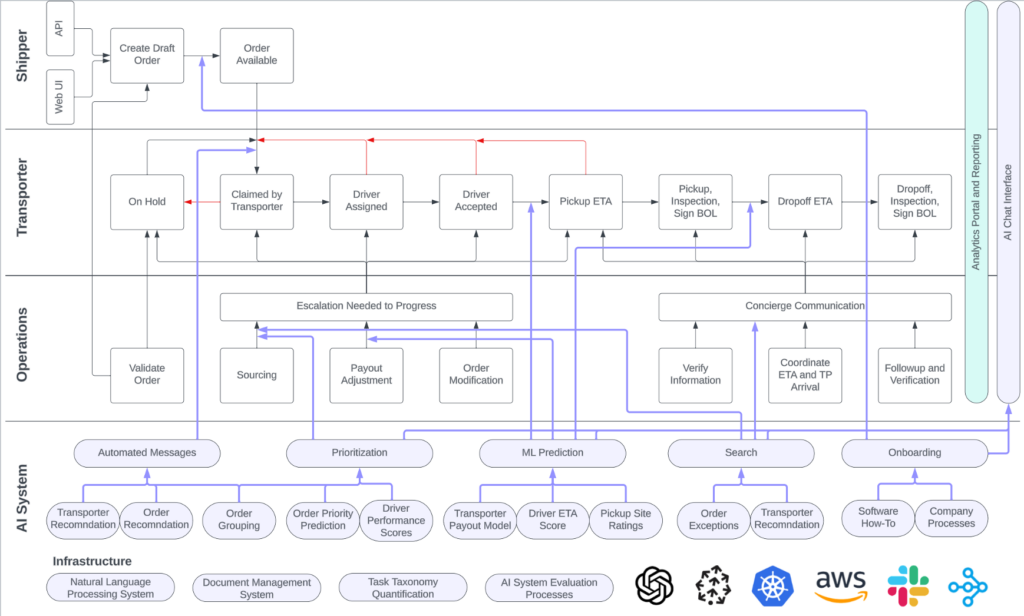Author: Dr. Patrick Weinkam, Head of Data Science

RunBot is a generative AI system used by RunBuggy and seamlessly integrated with their specialized software platform designed to optimize the workflow for shipping cars. The software at the heart of this revolutionary approach, called Winton, serves as the central nervous system, orchestrating the complexities of the automotive shipping process with unparalleled precision. From coordinating multiple stakeholders to ensuring timely deliveries, every facet of the shipping journey is managed with care.
The result is a dramatically improved experience for shippers and a reduction in operations overhead. The efficiency is driven by the software system, the data it generates, and the AI system trained on that data. In turn, the system can handle 85% of orders without major escalations, which require Operations specialists to intervene. However, for difficult cases, the AI system provides valuable insights.
AI Helps Operations Teams
For example, RunBot is used to prioritize Operational tasks using a Machine Learning model. The model can predict new orders that will be difficult to deliver with 80% accuracy and also uses information about the transportation network to identify stresses caused by lack of available transport companies. In such cases, a list of transporters is made available and ranked according to their preferred routes, truck/driver capability and location, as well as driver performance ratings [runbuggy.com/data-science-to-improve-the-runbuggy-digital-marketplace].
Also, each order is grouped with similar orders using a separate machine learning algorithm [runbuggy.com/introducing-runbuggys-order-pooling-engine]. These grouped orders are very attractive to transporters looking to optimize their payout per mile and are offered to the best performing drivers. This RunBot sourcing process provides efficiencies for all parties: the transporters are paid well by maximizing their capacity, cars are shipped more quickly with less problems for shippers, and less manual effort is needed by operations. Importantly, reducing empty miles also reduces our carbon footprint and helps companies achieve their climate initiatives.
AI Helps Software Automation
In fact, the biggest impact of the AI system is decreasing the number of problems that require manual operations effort. The RunBot sourcing mentioned above also directly feeds the Winton software, which sends automated messages to well matched transporters in the app or by email (Figure 1). Furthermore, the integration of driver rating mechanisms enhances accountability and quality control, and makes orders move faster. For example, RunBot identifies drivers that rarely provide accurate ETA’s, and in turn, the Winton system can message those drivers when in danger of delaying the shipment and escalate to operations for high priority moves. This type of interplay between the software system, transporter, and operations can result in complex edge cases that traditional software alone cannot easily handle.
LLM’s Broad Business Impact
The use of large language models (LLM’s) like ChatGPT is what takes the RunBot AI system to unprecedented levels. RunBot is trained on all of the knowledge and data of the RunBuggy transportation network and therefore provides unprecedented visibility. One can send a Slack message to RunBot, for example, to “see all orders that will be picked up from a Toyota dealership” or “show all orders that need sourcing in Florida”. Of course, you can follow up that question with “give me a list of transporters to move those orders.”
Also, LLM’s have the ability to make sense of conversations and complex written requirements, e.g. restrictive pickup hours or drop off locations. For example, if a transporter sends a message that they will arrive at 5 PM PST but the notes say the lot closes at 6 PM EST, RunBot immediately knows this is an issue whereas a person might not see the message until it is too late, which results in wasted time for the transporter and frustration for all parties.
Lastly, RunBot provides a vastly simplified interface to use our software systems as they can retrieve information and also teach internal and external users how to leverage the software correctly. RunBot effectively reduces onboarding time for such a complicated ERP-like system from months to a few weeks.
Conclusion
In summary, RunBot is an AI system that is uniquely positioned to bring revolutionary efficiencies to the automotive transportation world. While the AI technology is powerful, the real advantage is the vast amount of useful data from the RunBuggy systems and software built up over many years. Because RunBuggy is a digital marketplace, it can only be successful if all parties involved also succeed: the shippers, transportation companies, and operations teams. Therefore, the RunBot system has access to data as broad as software integrations from OEM’s and internet companies, to historical records and GPS of transporters, to hours of operations for repo lots. Those data are carefully curated and provided to the AI system to promote efficiency and reliability. The future of car shipping has arrived, and it is intelligent, interconnected, and poised for unprecedented success.
To learn more about RunBuggy’s Data Science and Artificial Intelligence initiatives, please visit runbuggy.com/runbot.


